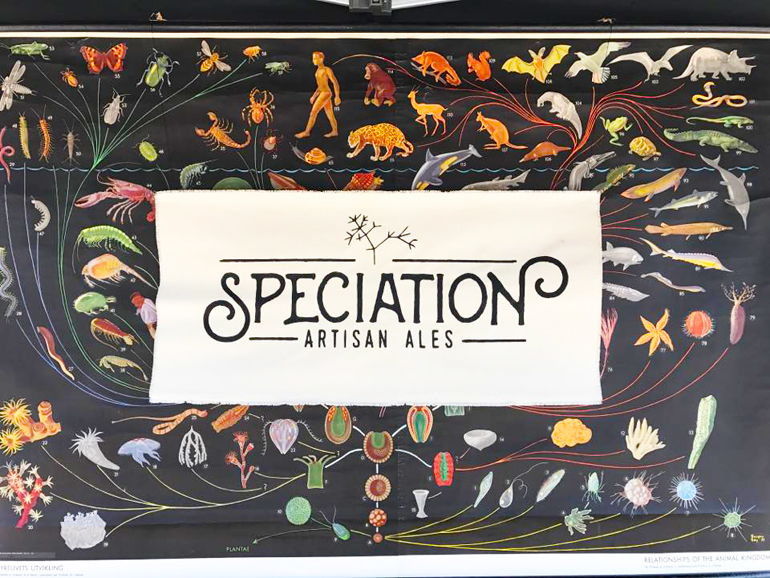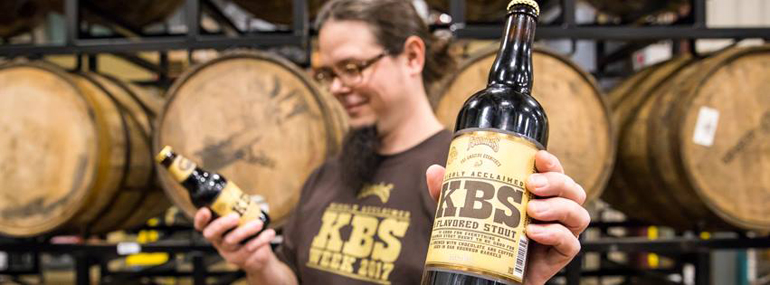Start 14-Day Trial Subscription
*No credit card required

The Brew Must Go On: A Case Study In Beer Production Methods (Issue 32)
Mitch Ermatinger spent a late July evening completely redefining his production calendar.
As the owner of Speciation Artisan Ales in Grand Rapids, Michigan, he has the luxury of making the drastic changes late into the year. Ermatinger also has the comfort of being at the helm of the two-employee operation, which will finish the year making approximately 150 barrels of beer.
“It’s totally haphazard,” Ermatinger said. “My whole schedule for the rest of the year changed because I sat down in front of a computer and was in the mood to make a production schedule.
“It’s not something a bigger brewery can do. It’s a huge benefit of being super tiny.”

Smaller breweries, like Speciation Artisan Ales, are more at the whim of available fermenters and the ability to produce as fast as demand dictates, for which some producers are under much more pressure than others.
With more than 6,000 breweries in the U.S., production methods vary greatly from brewery to brewery. Smaller breweries are more at the whim of available fermenters and the ability to produce as fast as demand dictates, for which some producers are under much more pressure than others. As breweries scale up in size, they’re forced into economies of scale, as well as consumer, distributor and retailer expectations.
The yeasts a brewery chooses to work with even further complicate production methods, whether it’s a wild or spontaneous fermentation or a controlled yeast environment.
With the range of breweries in the U.S., a close look at a specific market can showcase the diversity. With more than 50 breweries in the metro area, Grand Rapids is home to a wide range of brewery sizes offering a case study in production methods.
With Ermatinger and Speciation on the lower side of feasible breweries brewing 150 barrels to Founders Brewing Co., one of the nation’s fastest growing and largest breweries, set to brew more than 450,000 barrels by the end of 2017, and every size in between.
Unlike Speciation, Founders can’t impulsively change the way they’re pushing out beer. "Founders is continuously looking at its production calendar," said Brad Stevenson, the company’s Chief Production Officer.
In some cases, large breweries like Founders must begin planning years ahead of time.
With between 70 to 80 SKUs of products, Stevenson said the production team is always looking upstream to material planning — up to five years out — all the way downstream to what a distributor might need 10 weeks out.
“With general business planning, we’re three to five years out and we do that by brand,” Stevenson said. “Then we come to annual format, and right now we start that and by the end of October we’ll have talked to all our customers and figure out what next year looks like and come back with a detailed plan based on brand, even by SKU, by region.”
From there, Stevenson must figure out where capacity will be, as it’s a cyclical process. Founders ships more than twice as much beer in the summer than in the winter. They attempt to forecast best they can 10 weeks out, but take orders from distributors two weeks ahead of time. A beer takes more than two weeks to brew.
“I can’t just plan on a steady-eddy existence,” he said. “We plan, but it’s still just guessing, or as we say around here, ‘It’s all just lies.’”
Most breweries in Grand Rapids are relatively based on the model Founders has succeeded with in the city.
Mitten Brewing Co. was founded in 2012 and brewed approximately 600 barrels its first year and is expected to finish this year with 1,500 barrels. Owners Chris Andrus and Max Trierweiler know going from 6,000 to more than 450,000 barrels in 10 years as Founders accomplished is unlikely, so they’re constantly in a decision-making process of when to keep growing or when to stand pat.
“The biggest mistake now would to be to overbuild,” Andrus said. “We wait until a pain point presents itself and we have to expand. We’re still a mom and pop operation and spending our own money.”
The Mitten currently balances between supplying its taproom in a historic 1800s firehouse, which takes 75 percent of the brewery’s beer, a taproom in Northport, Michigan, and distribution across Michigan. The beer needed is balanced between the brewpub’s 3-barrel brewhouse and the production facility’s 20-barrel brew house. There’s currently no rush to push beer into distribution for the Mitten team.
They try not to run out of their flagship beers such as Country Strong IPA and the World Beer Cup award-winning Triple Crown Brown, but this summer the Mitten has run out of the brown ale twice, Trierweiler said.
The Mitten is expecting to launch a canning line later this fall, which will be accompanied by an expansion.
The balance between growth and sustainability is a common challenge for The Mitten Brewing Company. "We're not going to throw a bunch of money at a demand we're not sure exists," says co-owner Chris Andrus.
“We’re already having forward conversations with distributors,” Andrus said. “We’ll back into expansion goals from that forecasting. We’re not going to throw a bunch of money at a demand we’re not sure exists.”
Ermatinger decided against the classic brewpub model and went with a low overhead, small-scale model seen in other markets, but unseen and doubted at first in West Michigan. Selling out of the production facility once a month, Ermatinger creates a built-in demand for his beers.
To start his production, Ermatinger mixed yeasts from bottle dregs, wild yeast he harvested and a few strains from labs he enjoys. “It’s also super haphazard and loosey goosey,” he said. “It’s a random assortment of yeasts I really like and I just let it go. That serves as the base of every beer.”
His management of the yeast would send other brewers into a panic.
Brewery Vivant launched an official sour beer and wood aged program last year, which helps boost the company’s production capacity, while allowing the brewers to experiment with yeasts they’d otherwise be scared to use around the main production facility, which is capped at approximately 6,000 barrels. Brewery Vivant’s owners, Kris and Jason Spaulding want to maintain their neighborhood pub operation supplemented with distribution across Michigan and into neighboring states, but won’t sacrifice their morals to grow for sake of growth.
Brewery Vivant keeps its wild room separated by a wall and has its own bottling line and a stainless steel pipe from the brewhouse.

Brewery Vivant’s owners, Kris and Jason Spaulding want to maintain their neighborhood pub operation supplemented with distribution across Michigan and into neighboring states, but won’t sacrifice their morals to grow for sake of growth.
Founders recently added a full-time microbiologist and maintains a staff of yeast technicians to maintain the single-strain of yeast the brewery has always operated with, but it’s now able to be its own yeast provider. Founders also recently added a second strain of yeast, a lager strain, for its PC Pils.
Unlike most other breweries, Ermatinger brews his beers at other breweries, before bringing the wort back to his facility to ferment, however long it might take. Ermatinger can also choose what might accompany his base saison or golden ale based on what fruits are in season or what a local hop grower has on hand.
Most of Speciation’s beers spend up to eight weeks in stainless tanks or barrels, before spending another four to eight weeks conditioning in bottles. He has one batch of beer he expects won’t be ready for maybe more than a year.
“It’s super unpredictable,” Ermatinger said, who believes he has all the beers he needs brewed through November.
The unpredictability could potentially cause problems for Ermatinger. He sets up to three or four batches for sale during his once a month ticketed sale. If at least one batch isn’t ready, he could face the ire of thirsty customers. His back up plan is a deep cellar of previous releases.
A brewery the size of the Mitten can normally find a place for all its beer as soon as it’s made, no matter the style. A brewery the size of Founders does not have the same luxury.

Most breweries in Grand Rapids are relatively based on the model Founders has succeeded with in the city.
“That’s a phenomenon we experienced from our sixth or seventh year to just a few years ago, everything we made was sold,” Stevenson said of having a place to send beer before it was made. “Once we hit the brewhouse, we knew that beer was sold, we didn’t know where and didn’t have an order, but whatever we made was flowing out.”
Stevenson said that method of madness only works until a certain size. To push a volume Founders is making now it must have programs in place with large chain retailers.
“They need to know when they agree to put product XYZ on the shelf that it has to be there all the time, it’s not an option,” Stevenson said. “They need a steady flow and to that point, we’re monitoring 200ish distributors across the country.
“Most breweries are still in the mode where there’s a place for their beer to do. Just a few dozen of us have to do what we do.”
(Photos courtesy respective breweries)



